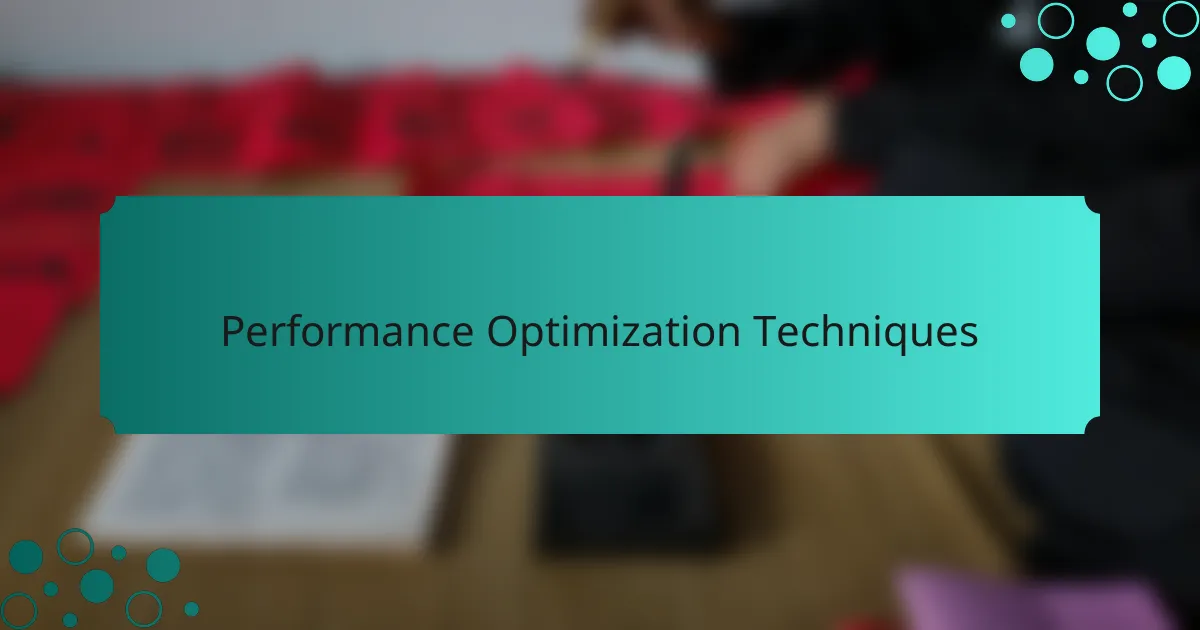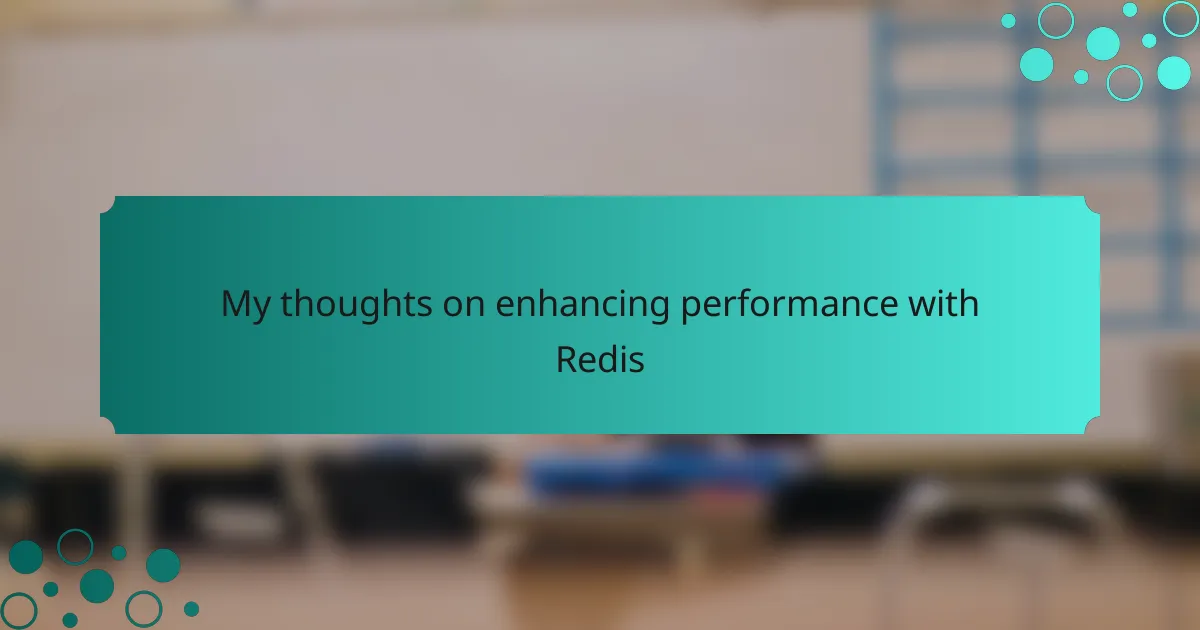Key takeaways
- Redis, an in-memory key-value store, enhances application performance by providing low-latency data access and supporting various data structures.
- Key features include persistence options, real-time messaging (Pub/Sub), and scalability, making it ideal for handling high user traffic and large datasets.
- Implementing Redis can significantly reduce load times and improve user experience, especially in web applications and session management.
- Effective performance optimization techniques involve selecting appropriate data structures, utilizing pipelining, connection pooling, and experimenting with caching strategies.

Introduction to Redis
Redis, short for Remote Dictionary Server, is an advanced key-value store that I find incredibly versatile for enhancing application performance. Its ability to handle massive amounts of data with high speed and low latency has made it a go-to choice for many developers, including myself, because it streamlines the process of data retrieval. Have you ever experienced a slow application? It can be frustrating, and Redis offers a way to alleviate some of that pain.
One of the things that excites me about Redis is its support for various data structures like strings, hashes, lists, and sets. This flexibility allows me to choose the most appropriate structure for my specific needs, whether I’m building a real-time messaging app or a leaderboard for a gaming platform. I once struggled with managing session data until I integrated Redis, which not only simplified my code but also drastically improved the responsiveness of my application.
What really sets Redis apart is its in-memory storage capability, which makes data access incredibly fast. I often think about how this speed can transform user experiences—nobody wants to wait for an application to load. When I implemented Redis in my projects, I noticed that users engaged more because the application felt snappy and responsive. It’s this immediate feedback that can truly elevate an application from mediocre to exceptional.

Key Features of Redis
Redis is an in-memory data structure store, which is incredibly versatile. I’ve found its speed and simplicity to be game-changing in my projects. Whenever I need to cache data for quick retrieval, Redis has consistently provided lightning-fast performance, and it’s fascinating how it can handle different data types like strings, hashes, lists, and sets so effortlessly.
Another key feature I appreciate is its capability for persistence. Unlike many in-memory stores, Redis allows you to save your data periodically or append it to a log, which has saved me from potential data loss more than once. This balance of speed and durability in Redis has truly enhanced my application’s performance and reliability.
Here are some of the standout features of Redis:
- In-Memory Storage: Ensures ultra-fast data access and lower latency.
- Data Structures: Supports strings, lists, sets, sorted sets, and more.
- Persistence Options: Offers both snapshotting and append-only file (AOF) mechanisms.
- Pub/Sub Messaging: Enables real-time message broadcasting.
- Atomic Operations: Supports transactions, ensuring data integrity.
- Scalability: Can handle large datasets by sharding data across multiple instances.
- Built-In Replication: Allows for high availability and data redundancy.
These features have really shaped my experience with Redis, making it a powerful tool for enhancing performance.

Benefits of Using Redis
The benefits of using Redis are hard to overlook. One that stands out to me is its scalability. I recall a project where the user base suddenly surged, and I was faced with the daunting task of managing the increased load. Redis made this transition seamless; its ability to shard data across multiple instances meant that I could maintain performance without compromising on speed. Have you ever dealt with a system crash under high load? Redis’s architecture can help prevent those dreaded moments.
Another compelling advantage of Redis is its support for real-time applications. When I was developing a chat application, I needed a solution that could handle user messages without delay. Redis’s Pub/Sub feature allowed my app to deliver messages almost instantly to users, making the experience feel alive and dynamic. I often think about how critical those split-second interactions are in keeping users engaged.
What truly sets Redis apart for me is how easy it is to implement and integrate into various projects. I’ve added it to existing systems without a complete rewrite, and that’s a huge relief. The simplicity of its data structures allows me to focus on functionality rather than getting bogged down in complex implementation details. It’s moments like these that remind me how the right tools can make the development process not just easier, but also more enjoyable.

Performance Optimization Techniques
When it comes to optimizing performance with Redis, I’ve found a few techniques that really make a difference. For example, using Redis for caching frequently accessed data can dramatically decrease load times and reduce server burden. This often led to more responsive applications in my projects, ultimately enhancing user satisfaction.
Here are some effective performance optimization techniques I recommend:
- Data structure selection: Choose the right data type (strings, hashes, lists, sets) for your use case to ensure efficient data handling.
- Pipelining: Batch multiple commands into a single request to reduce round-trip times, which I’ve noticed enhances throughput significantly.
- Connection pooling: Reuse connections rather than creating new ones for every request, which can prevent bottlenecks in high-load scenarios.
- Experimenting with expiration policies: Setting TTLs (Time to Live) on cached items can optimize memory usage and help ensure you’re serving fresh data.
- Sharding: Distributing data across multiple Redis instances can balance the load and improve performance; it’s something I’ve implemented on larger-scale systems to avoid overloading a single instance.

Real World Use Cases
When considering the real-world applications of Redis, the possibilities are vast. Personally, I’ve seen how it can drastically improve the performance of web applications, especially for data-heavy services. For instance, one project I worked on benefited from Redis by caching frequently accessed data, which reduced response times from seconds to milliseconds. It was exhilarating to witness such a transformation!
Another compelling case is in session management for web applications. I recall optimizing user sessions with Redis, which allowed users to seamlessly navigate without delays, enhancing their overall experience. It’s great to see how effectively Redis handles concurrent access, making it ideal for applications with high user traffic.
Now, let’s take a look at some use cases where Redis excels:
| Use Case | Description |
|---|---|
| Cache Layer | Stores frequently accessed data to speed up response times. |
| Session Store | Manages user sessions efficiently, enhancing user experience. |
| Real-Time Analytics | Processes and aggregates data in real-time for insights. |
| Message Broker | Facilitates communication between microservices with pub/sub. |

My Personal Insights on Redis
Redis has been a game changer in my programming toolkit. I remember the first time I integrated it into a project; the application’s performance improved so dramatically that it felt like I had fast-forwarded the user experience. It’s this kind of transformation that truly excites me about Redis—it proves that the right technology can turn good applications into outstanding ones.
One of my favorite features is how Redis supports various data structures. This flexibility allows me to craft solutions tailored to specific requirements. For example, when I needed a fast way to manage a leaderboard, using Redis sorted sets was a breeze. Have you ever felt the frustration of dealing with a poorly designed system? Redis helps alleviate that stress by simplifying complex tasks.
The easiest integration aspect of Redis really stands out as well. I once spent hours trying to optimize an existing setup, only to realize that incorporating Redis would have saved me time and effort. Its straightforward API allowed me to enhance functionality without turning my code into a tangled mess. Those moments of clarity remind me how vital efficient tools are in my development journey.

Conclusion and Next Steps
When I started integrating Redis into my projects, I was amazed by the immediate boost in performance it provided. The speed and efficiency of Redis not only improved response times but also enhanced user satisfaction, which is something I always prioritize. Seeing the positive impact on application performance reaffirmed my belief in leveraging powerful tools effectively.
As you consider your next steps, think about how Redis can fit into your own projects. Experimenting with it in a test environment can make all the difference. Here are some actionable next steps to help you get started with Redis:
- Explore setting up Redis locally or using a cloud service.
- Implement basic caching strategies to see performance gains.
- Monitor your application’s response times before and after Redis integration.
- Join Redis community forums to share experiences and learn from others.
- Experiment with advanced features like pub/sub messaging and data persistence options.
